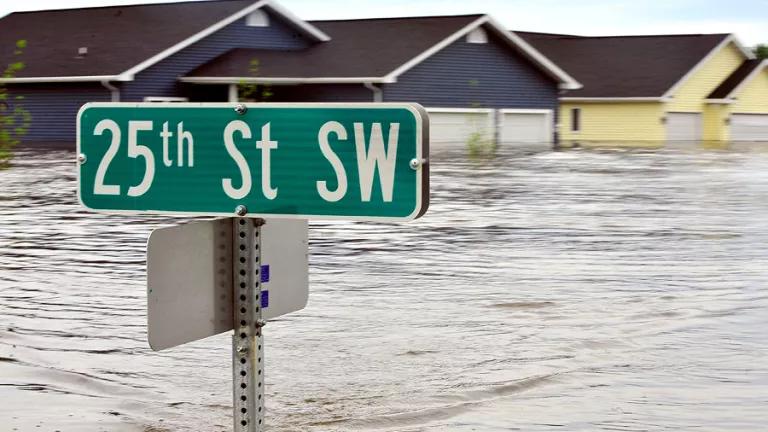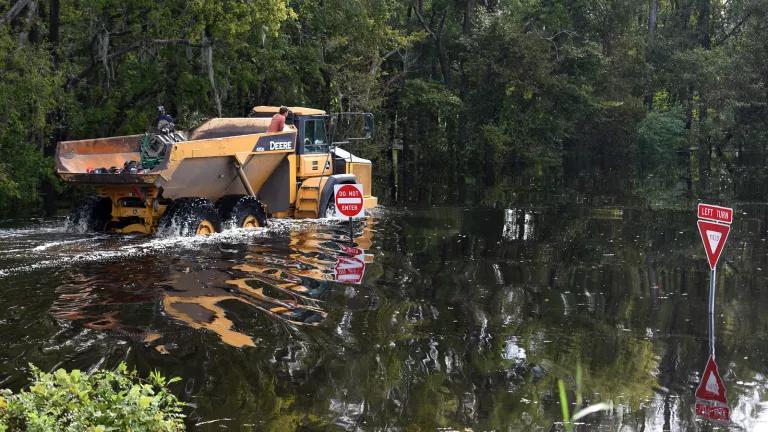
Flooding is on the rise, if you'll excuse the pun. And floods will become more likely and more costly as the climate continues to warm.
My NRDC colleague, Becky Hayat, and I co-authored a new paper that recommends some important reforms to the National Flood Insurance Program (NFIP). The paper appears in the newest edition of the Environmental Law Reporter.
Our idea is simple -- let's make it easy for people to move away from areas at greatest risk of flooding. The reforms we recommend could transform the NFIP from a program that prolongs flood risk and is a serious financial liability into one of the best tools the nation has to prepare for the impacts of climate change and decrease our current and future vulnerability to floods.
The paper comes out just as new statutes for federal flood insurance premiums go into effect, which phases in new flood insurance rates for some properties, but could impact families across America who can least afford it. As Becky and I point out, there are much better ways to address issues of flood insurance affordability that can also assist people who want to move to higher ground and out of flood-prone areas.
There has been an ongoing national debate about the price of federally backed flood insurance through the NFIP. At the heart of the debate has been discussion of how to best address the fact that roughly 20 percent of NFIP policy holders have not paid risk-based rates for insurance. Paying risk-based rates could result in steep price increases for flood insurance coverage. While this would send the right price signal about flood risk, it would also be an unfair burden for low-income homeowners.
But the alternative is to keep insurance prices artificially low. This may ease the financial burden of living in areas that have flooded in the past and will flood in the future, but if people will continue to live in these areas then the NFIP and taxpayers will keep paying to rebuild those properties. And this problem only grows as the climate warms, sea levels rise, and the risk of flooding increases. The cycle continues until people give up and abandon their property, or expensive flood barriers are erected at public expense (which could fail), or some other intervention happens.
NRDC wants to help people move out of harm's way sooner, while keeping flood insurance affordable for those who can't pay risk-based insurance premiums. Our proposal is to continue to offer flood insurance at a discounted rate to low- and middle-income property owners and in return, FEMA would commit to buying out those properties after the next major flood.
Our idea is consistent with a recommendation by the National Academy of Sciences that lower insurance premiums could be made available when property owners take action to reduce their risk of flooding. Our proposal would do just that, and would also get property owners to take the ultimate mitigation action -- permanently moving out of harm's way.
What would the homeowner get out of this proposal?
Low- and middle-income homeowners would be able to buy insurance at a much lower price than risk-based rates. They'd be able to stay in their home and community and they wouldn't see their home devalued by exorbitant flood insurance rates. In return for lower insurance prices, those homeowners would commit to accepting a buyout if and when their property is substantially damaged (a term defined by FEMA as damage in excess of 50 percent of the property's value) by a future flood event. Those property owners would also be guaranteed a buyout for the full pre-flood value of their home.
Ideally, this agreement would be tied to the property itself, not to the individual owner. If someone purchased the property, they would have the option of maintaining the agreement and continuing to get discounted insurance rates. Doing so, would help prevent properties from being devalued as a result of increasing flood insurance prices. But if a new owner didn't want to maintain the agreement, they have the option of paying the full risk-based price of coverage under the NFIP.
What would the nation get out of this?
The main benefit is a gradual reduction (over a period of several decades) in our nation's vulnerability to flooding and a reduction in the cost of repeatedly rebuilding in the wake of a flood. We would reduce the number of people who live in low-lying areas that are susceptible to damage from floods, either from rivers overflowing their banks or from the storm surges that accompany hurricanes and tropical storms. Folks who take advantage of this proposal will get cheaper insurance. But after a major flood, these same people may have their properties purchased without any of the normal red tape. The result is that fewer and fewer people will live in areas that will be flooded in the next storm. Once properties are bought out, future redevelopment would be prohibited.
There are millions of properties in the nation's floodplains and more people will live in floodplains in the future, thanks in part to climate change and rising sea levels. We must make it easier for people to move to higher ground.
Who would be eligible?
Under NRDC's proposal, only low- and middle-income people could take advantage of this offer. Homes that cost less than $250,000 would be eligible, the maximum insurable value under the NFIP. This would ensure that only those most in need of insurance coverage, but least able to afford it, are protected. It would also prevent wealthy beach-front vacation homeowners from cashing in and getting their losses covered. Wealthier property owners would be ineligible, thereby forcing them to accept the risks of where they live.
Furthermore, this option shouldn't be available everywhere. It be made available in areas most vulnerable to flooding. Regions where sea-level rise projections indicate large numbers of properties at risk, coastal areas vulnerable to storm surges, and neighborhoods that have a high number of repeatedly damaged properties all would be good candidates.
Wouldn't a guaranteed buyout just encourage people to build in flood-prone areas?
This option should only be available to pre-existing homes, not new construction. The point of this is not to guarantee everybody a buyout when their property is flooded. The point is to provide affordable insurance to people who can't pay risk-based insurance premiums and ensure they can move to higher ground when they've lost their home to a major flood.
Wealthier property owners, who can afford to pay risk-based insurance rates, or choose to forego flood insurance entirely, would not be able to get the kind of buyout guaranteed by this proposal.
How is this different than FEMA's current approach to buying out flooded properties?
The biggest difference is time. Currently, FEMA-sponsored buyouts are only offered in the aftermath of a flood and can take years to complete. This is a huge deterrent, especially for low-income residents.
After a flood, here's what currently happens:
- Residents with NFIP coverage receive a check for damages from FEMA, usually within weeks of the flood.
- FEMA and the state may decide to use post-disaster assistance to buy out properties that were damaged. Homeowners can apply to have their home bought out by filing all the required paperwork. It can take two to four years before a homeowner finds out if his or her property is going to actually be purchased.
- In the meantime, a property owner will use his or her flood insurance check to repair their home. If the property was substantially damaged by the flood, the homeowner will also be required to raise the property one foot above the elevation of the 100-year flood. If elevation is required, there is FEMA assistance available, but the owner usually bears some of the cost as well.
- Now the kicker. If it's determined that their property is going to be purchased, then they'll get an offer for the assessed value of their home minus the amount of their flood insurance claim that they received in the aftermath of the flood. That means they receive a buyout that is for less than the value of their home!
To summarize, homeowners are only offered buyouts after a flood has already happened, the buyout is usually for less than the full value of the home, and it can take years to see their property purchased.
Doesn't sound like a very attractive option, does it? For a lot of people rebuilding and hoping you don't get flooded again is a lot easier, which is one reason why so few people take advantage of buyouts.
Under NRDC's proposal, the homeowner would agree to be bought out and all the required information would be filed with FEMA well in advance of a flood (when people tend to have ready access to records). If their home is substantially damaged, they'd receive a check for the full value of their home within weeks, not just the value of the damages. And that's it! As with conventional buyouts, the property would be demolished and the land left undeveloped.
Time for a New Response to Rising Flood Risks
Across the Midwest, rivers are flooding more frequently. Along our coastlines, sea level rise puts hundreds of thousands, if not millions, of homes at greater risk of flooding. Not counting damages associated with storm surge from events like Hurricane Katrina (2005), Superstorm Sandy (2012), and other tropical storms and hurricanes, average annualized flood damages since the year 2000 average over $8 billion per year. When those storms are taken into account, the damages are far higher. The rising damages from floods are why the NFIP is currently $23 billion in debt.
Sea levels are expected to rise between a foot and six feet by the end of the century, ultimately putting a lot of properties literally under water. For low-income homeowners, rising waters will increasingly erode the value of their home, putting their homes figuratively underwater.
The way the NFIP works, the nation keeps paying property owners to rebuild in the same areas that just flooded. If a homeowner is motivated to move out of harm's way, FEMA requires them to endure a long process to receive less than the full value of their home. This is a situation that is simply untenable and is made all the more problematic by the impacts of climate change.
There has been a long, simmering debate on flood insurance going back to the Biggert-Waters Flood Insurance Reform Act of 2012, where flood insurance subsidies were phased out for a large number of properties across the nation. In 2014, Congress restored many of those subsidies out of concern for flood insurance affordability through the passage of the Homeowner Flood Insurance Affordability Act (HFIAA). In fact, today is the day that many of these new provisions go into effect. Most of the debate revolves around the issue of flood insurance costs and how we can make it affordable.
But it's high time we talk about how we manage the increasing risk of flooding due to climate change. NRDC's proposal is intended to put a novel idea on the table for how to manage the nation's long-term flooding risks, while also addressing the affordability concerns for those who can't pay the full price of flood insurance.




